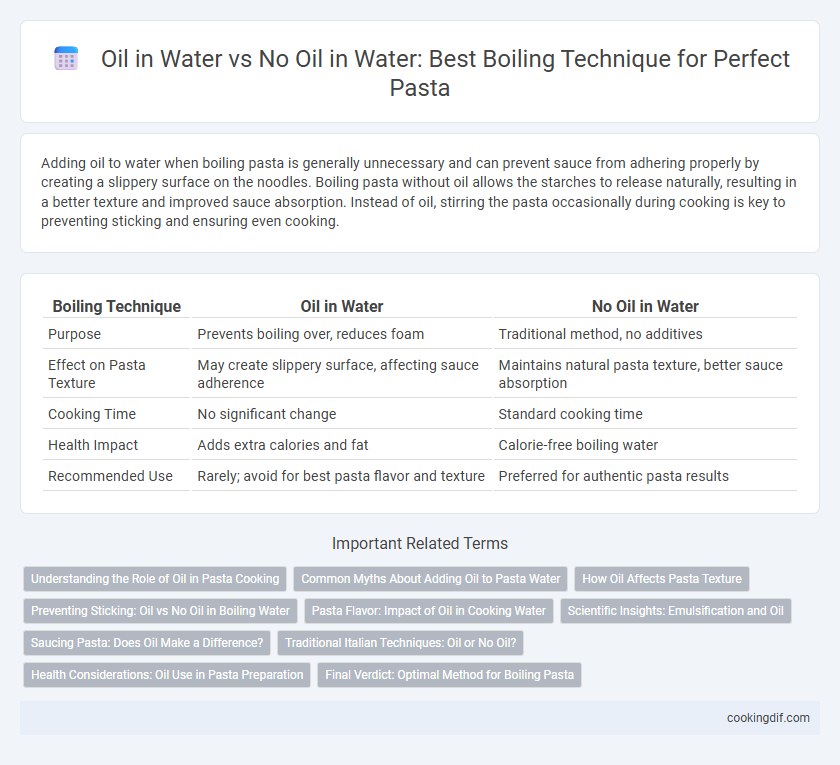Adding oil to water when boiling pasta is generally unnecessary and can prevent sauce from adhering properly by creating a slippery surface on the noodles. Boiling pasta without oil allows the starches to release naturally, resulting in a better texture and improved sauce absorption. Instead of oil, stirring the pasta occasionally during cooking is key to preventing sticking and ensuring even cooking.
Table of Comparison
| Boiling Technique | Oil in Water | No Oil in Water |
|---|---|---|
| Purpose | Prevents boiling over, reduces foam | Traditional method, no additives |
| Effect on Pasta Texture | May create slippery surface, affecting sauce adherence | Maintains natural pasta texture, better sauce absorption |
| Cooking Time | No significant change | Standard cooking time |
| Health Impact | Adds extra calories and fat | Calorie-free boiling water |
| Recommended Use | Rarely; avoid for best pasta flavor and texture | Preferred for authentic pasta results |
Understanding the Role of Oil in Pasta Cooking
Adding oil to boiling water when cooking pasta is often debated, but it primarily prevents starch from escaping and reduces foam, rather than improving texture or preventing sticking. Cooking pasta in plain, heavily salted water allows the starch to release naturally, which helps sauce adhere better to the noodles. The most effective way to avoid sticking is to use enough water and stir the pasta regularly during the first few minutes of cooking.
Common Myths About Adding Oil to Pasta Water
Adding oil to pasta water is a common myth believed to prevent sticking, but in reality, it creates a slippery surface that hinders sauce adhesion. Pasta sticks primarily due to insufficient water volume or lack of stirring, not the absence of oil. Boiling pasta in ample water and stirring occasionally ensures proper texture without compromising flavor absorption.
How Oil Affects Pasta Texture
Adding oil to boiling water creates a slippery surface that can prevent pasta from sticking together, but it also forms a thin coating on the pasta that hinders sauce absorption, resulting in a less flavorful texture. Without oil, pasta releases starch into the water, which helps sauces cling better and enhances the overall mouthfeel with a firmer bite. The choice impacts the texture significantly: oily water leads to slick, less cohesive pasta, while plain water promotes a more integrated, textured final dish.
Preventing Sticking: Oil vs No Oil in Boiling Water
Adding oil to boiling water when cooking pasta creates a thin film that can reduce water absorption and hinder sauce adherence, whereas omitting oil allows pasta to cook evenly and stick less due to the starch released into the boiling water. The natural starch in pasta water acts as a binder for sauces, enhancing flavor and texture when oil is not used. Proper stirring during the first few minutes of boiling is the key technique to prevent sticking effectively without compromising sauce adherence.
Pasta Flavor: Impact of Oil in Cooking Water
Adding oil to pasta boiling water can create a thin film on the pasta surface, which may hinder sauce adherence and reduce overall flavor absorption. Without oil, pasta maintains a porous texture that better soaks up sauces, enhancing the final dish's taste profile. Cooked pasta without oil in the water preserves its authentic flavor and texture, making it ideal for flavorful sauce pairing.
Scientific Insights: Emulsification and Oil
Adding oil to boiling water when cooking pasta creates a thin oil layer that prevents water from foaming and boiling over but does not prevent pasta from sticking scientifically. Oil and water form an emulsion where oil droplets float on the water surface, reducing surface tension but failing to coat pasta effectively due to oil's hydrophobic nature. For optimal pasta texture and sauce adherence, it is more effective to reserve pasta cooking water's starch-rich liquid rather than relying on oil in water.
Saucing Pasta: Does Oil Make a Difference?
Adding oil to boiling water when cooking pasta can prevent sticking but may also create a slippery surface that hinders sauce adherence. Without oil, pasta absorbs sauces more effectively, enhancing flavor integration and texture. Optimal saucing relies on pasta's natural starches released during cooking, which bind better without oil interference.
Traditional Italian Techniques: Oil or No Oil?
Traditional Italian techniques for boiling pasta emphasize not adding oil to the water, as oil can prevent the pasta from properly absorbing the sauce by creating a slippery surface. Instead, using plenty of salted water ensures even cooking and enhances the pasta's flavor while allowing the sauce to adhere better. This method preserves the authentic texture and taste essential to classic Italian pasta dishes.
Health Considerations: Oil Use in Pasta Preparation
Adding oil to pasta boiling water is generally discouraged due to its minimal effect on preventing sticking and its potential to create a greasy texture that interferes with sauce adherence. Health-wise, introducing oil into boiling water does not significantly alter nutritional value but may contribute to unnecessary caloric intake if excess oil clings to the pasta. For optimal health-conscious pasta preparation, boiling without oil and using adequate water with occasional stirring ensures proper cooking and maintains sauce compatibility.
Final Verdict: Optimal Method for Boiling Pasta
Adding oil to boiling water when cooking pasta is generally discouraged because it can create a barrier that prevents sauce from adhering properly, affecting flavor absorption. The optimal method involves boiling pasta in salted, unsalted water without oil to ensure even cooking and maximum sauce retention. This technique preserves the pasta's texture and enhances the overall dish quality, as confirmed by culinary experts and food scientists.
oil in water vs no oil in water for boiling technique Infographic

 cookingdif.com
cookingdif.com